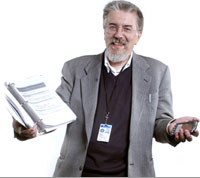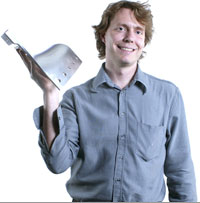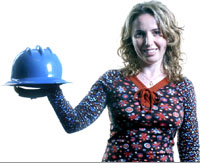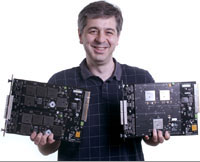 |
 Enrico Onofri
Enrico Onofri
University of Parma and Theory Group,
with all-important notebook and personal organizer
Parma, Italy, is a 2000-year-old town established as a
Roman camp on the way to Gallia. The University
of Parma has some 30,000 students and a unique Science Campus. Parma is better known for its food
than for its university, but this is because the food is REALLY good—parmesan cheese, prosciutto
ham, much more. I first came to Fermilab briefly in 1976 while on a NATO fellowship at Princeton. The
site was beautiful, like today, and the physics was at the frontier, like today. I returned as a visitor for
several summers, and now I am on sabbatical from Parma. I'm more an applied mathematician than a
physicist, but my main goal is solving problems in theoretical physics. At the moment I am after a
problem in two-dimensional quantum field theory. Two dimensional space-time has been a
kind of playground for theorists, but it could be more important than we believe. I'm too
old to work on such frontier problems as quantum gravity, or M-theory, or
noncommutative geometry. I hope to really understand the nature
of quark confinement and the role of non-perturbative effects in
quantum chromodynamics. It's an old problem, and many people
claim to have the solution, but I believe that we are still far from a
satisfactory solution. As a boy, the main attraction for me was
mathematics. Such books as Hilbert-ConVossen, "Intuitive
Geometry," and Courant-Robbins, "What is Mathematics?" were
on my desk together with Carl Barks' "Donald Duck" (I keep all of
these at my fingers even today). The quest for Nature's inner secrets,
started by the Greeks, continued by Kepler, Galileo, Newton, Maxwell,
Einstein, Fermi…it represents the highest of human aspirations and should be
supported by all countries which claim to be civilized. In my late years as a professor
in Italy, I'll fight this battle!
|
 |
 |
 Michel Sorel
Michel Sorel
Columbia University and MiniBooNE,
with MiniBooNE horn components
The first time I came to Fermilab was in 1996, as a summer student from
the University of Bologna, to learn physics and to contribute to the upgrade
of the CDF detector. I've kept an excellent "souvenir" of that summer.
It made it easier for me to decide to start a Ph.D. at a U.S. institution three
years later. I came back to Fermilab two and a half years ago, this time to
study neutrinos. In the near-term, I will do my best to contribute to the first
physics results of MiniBooNE. This is a pretty exciting and busy time for us!
I have not made up my mind on what Id like to do next: I may continue with
neutrinos, or perhaps learn about cosmology. It is also going to depend on
what MiniBooNE sees. Doing research in physics is for me both a noble and
fun activity—noble, because it is motivated by the general interest of
knowledge; and fun, because it requires a certain dose of personal
creativity, unlike many other jobs! Getting to continuously contest your
points of view with those of other physicists adds to the fun.
|
 |
 |
 Chris Hays
Chris Hays
Duke University and CDF,
with papers
I came to Fermilab as a graduate student on NuTeV, stayed to do my thesis
work at DZero, and now I'm a post-doc at CDF. I am working on the offline
tracking, and on searches for new particles. Most recently, I have worked on
a search for doubly-charged particles decaying to leptons. The CDF tracking
chambers will be the key components of a number of the world's best
measurements, crucial steps toward understanding the origin of mass and
of the matter-antimatter asymmetry in the universe. The search for doublycharged
particles has the potential to dramatically alter our view of the
universe. If we find a doubly-charged Higgs particle, it will provide
circumstantial evidence for a right-handed weak force, a completely new
force with new particles and interactions. With this new force, the low
neutrino masses could be explained as a by-product of the large scale at
which the left-right symmetry is broken. What motivates me in my day-to-day
work is simple curiosity, a drive to understand how things work at the most
fundamental level. What motivates me to give my life to improving our
understanding of the universe is the belief that an understanding of the
universe provides an important perspective on our place in it. We do not
just live in the universe, we are a part of it. Understanding how it works
gives us a sense of what our role in the universe is, and what it can be.
|
 |
 |
 Amber Jenkins
Amber Jenkins
Imperial College, London, and DZero,
with CP Violation teddy bears
As a scientist, I believe that communication is vital. What good is
our research if we are not able to share it? Particle physics is a very
esoteric subject, so we have to think outside the box to do this. I once
explained the concept of CP violation to my boyfriend using teddy
bears….an amusing yet highly effective method!! For me, coming to
Fermilab is a once-in-a-lifetime opportunity. We are working together in
an international collaboration sharing a common goal and similar passions.
We are asking the most fundamental questions of the universe: Where do we
come from? How was the universe created? How will it end? These are the most
challenging questions humanity can ask, and for me the most inspiring ones. In
the short term, I hope to complete my Ph.D.! I want to continue my research, and
to always be excited and challenged by the work that I do. I would like to travel
and see more of the world and of other cultures, to have a family and share my
passions with my children. And to never stop learning. I am amazed and inspired
by the people I meet: by their dedication, motivation and thirst for knowledge.
|
 |
 |
 Simona Murgia
Simona Murgia
Stanford University and MINOS,
with hardhat
I am originally from Cagliari, Italy.
I left my beautiful island, Sardinia, to attend graduate school
at Michigan State University, and soon joined the CDF collaboration. It is a very exciting time for
neutrino physics. Other experiments have led us to believe that neutrinos have mass, and the
goal of MINOS to detect and verify neutrino oscillations, and to make mass measurements.
That final stage, the measurement, is a big part of what makes the work of an experimental
particle physicist gratifying. The near and far MINOS detectors
are being built and tested before data taking begins in
early 2005, when a beam of neutrinos will be sent from
Fermilab to a mine in northern Minnesota, where the far
detector is located half a mile underground. I spent
some time in Minnesota this past winter working on
the detector assembly and commissioning. As the
detector is being built, plane by plane, the data coming
in—mostly from cosmic muons—is recorded, and we are
searching for a signature from atmospheric neutrinos. The detector
is already being put to work before it is even completed! It is very
impressive how much work it takes before an experiment goes on-line,
but in the end everything comes together and we learn something new.
|
 |
 |
 Levan Babukhadia
Levan Babukhadia
SUNY at Stony Brook and DZero,
with Central Track Trigger digital boards
I find it fascinating that as a physicist,
not only can I ask the "big questions" about
Mother Nature, but also work day-to-day on actually finding answers. At the Tevatron,
the world's energy frontier, I'm working on searches for a Higgs particle. Central as it
is to the Standard Model, the Higgs itself is a window to new physics. And I'm excited
working on searches for supersymmetric Higgs, particularly promising at these early
stages of Run II. Earlier, as a leader of a team of physicists and engineers, I worked
on the fast, digital Central Track Trigger for DZero in Run II, and in particular the VHDL
firmware, or 'brains', for its 500+ FPGAs. I've worked on Atlas at CERN, on inclusive
jet cross sections in Run I, and in theory and phenomenology. Back in Tbilisi, Georgia,
I started as a theorist working on topological field theoretical models
in (2+1) dimensions, which are interesting because the
Chern-Simons interaction provides an alternative to the
Higgs mechanism. Since then I have also worked on
models of weak and strong interactions. As exciting as
it is to be able to work on such a variety of topics, it is
intriguing that ordinary matter as we know it seems to
comprise only a tiny fraction of our universe. So I am
sure there are a lot of surprises awaiting us in the near
future, as we attempt to unveil the nature of the Higgs
and of supersymmetry, if it's there, and of dark matter
and maybe even of dark energy.
|
 |
 |
|

